What follows is an intimate look behind the scenes of a few images representative of the bulk of my outdoor photography. Here you will find discussions about things you may have wondered about, for example the classic “Why is the sky blue?”, to more esoteric thoughts you may not have, for example, “What is that bright light in the sky?”
AIRGLOW: Why aren’t your night sky pictures blue?
During nighttime the color of the sky is affected primarily by the moon and/or by solar influences upon our upper atmosphere, even though it is completely dark: airglow. From a dark site modern digital cameras can easily see this airglow, although color perception in low light levels is severely hindered in human vision. Airglow frequently changes throughout the night, sometimes appearing as waving arms of green and/or reddish light, analogous to the Aurora Borealis. Sometimes it’s a yellow or dark orange color, and occasionally it’s simply not there. Every night is a surprise!
The green airglow is a result of the atmosphere up to ~100 km luminescing due to the excitation of oxygen atoms from both ultraviolet light and cosmic rays from space. You can also see arms of red airglow, which extends as high as 300 km above the earth’s surface. For those of you that think the green airglow looks a bit like the aurora borealis, that’s not far off, as the mechanism of luminescence is quite similar, although the ephemeral nature of aurora is due to the variability of outbursts of the sun’s electromagnetic radiation.
So, I guess this is the time to just come right out and say that I am not an Instagram-Turn-The-Sky-Blue photographer; just as I would not consider artificially coloring every sunset orange and turquoise, as a photographer I want to present the night sky in a way that pays respect to the conditions of the night during which the images were captured. Blue night skies only occur during twilight and when the moon is above the horizon; you will accordingly see blue skies in some of my night photographs, but only when the sky was actually blue.
Similarly, the core of our Milky Way Galaxy is not grey and colorless; for some reason many photographers choose to de-saturate it, even though under dark skies human vision can perceive that our galaxy is indeed a warm amber color. Both airglow and light pollution from towns can affect the color of both the sky and the Milky Way core, and many astrophotographers strive to remove one or both of these color casts in order to render stars, nebulas and galaxies in their correct colors; I get that. For wide angle panoramic images of night skies, I personally consider airglow to be a feature (not a ‘bug’), and thus choose to allow it to remain in my images.
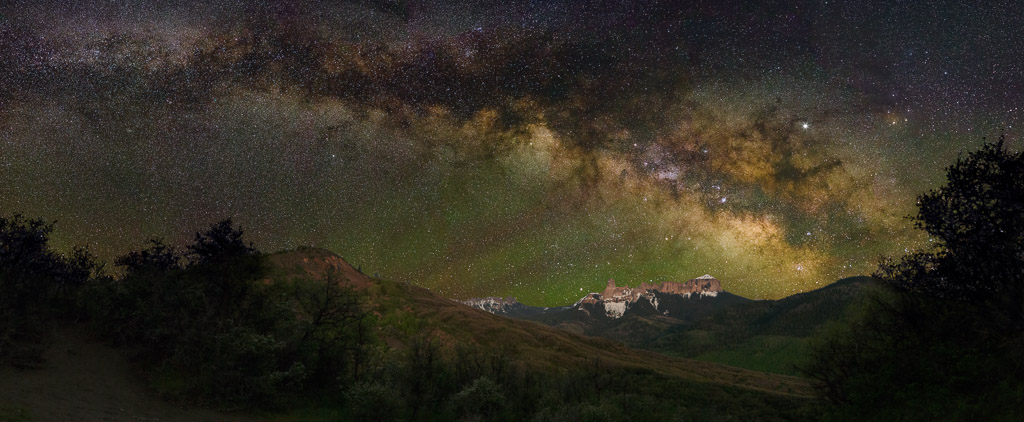
THE TWILIGHTS: Why are so many of your low-light sky pictures blue?
Since I presume you’ve spent some time on this site, you’ve probably heard me talk about the quality of light during twilight, which occurs both prior to sunrise and after sunset. The three phases of twilight in between day and night offer an observer the entire range of light that the earth within our solar system has to offer, while nighttime covers the period during which the sun is more than 18° below the horizon (in this case, the example below is for sunset):
…SUNSET
Civil Twilight: Sun is 0-6° below horizon; sun can (indirectly) cast a strong, sometimes warm-colored glow on terrain
Nautical Twilight: Sun is 6-12° below horizon; ‘Blue Hour’, caused by absorption of other colors of light by ozone in the atmosphere
Astronomical Twilight: Sun is 12-18° below horizon; high clouds appear to glow with color, terrain is nearly dark
NIGHT…
If you’ve ever sat and contemplated an entire sunset, you may have noticed that as it begins to get dark, a dark blue arc appears on the horizon, often with pastel-pink or purple light above. This is the earth’s shadow approaching your location as the sun progresses below the horizon behind you, while the upper atmosphere remains in sunlight, coloring the light differently. The panorama below was captured during Civil Twilight, when the sun was approximately 2° below the horizon, casting the shadow of the earth far toward the eastern horizon.

20 MINUTES LATER: e.g. how quickly light changes!
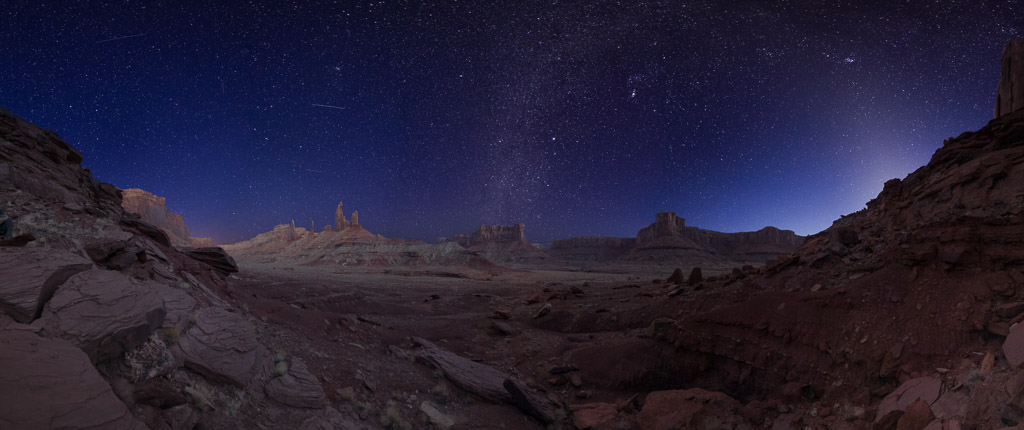
The length of time that the progression of the phases of twilight takes depends upon latitude and season; in mid-latitudes it generally takes around 90 minutes from sunset to full darkness (night). In the case of these two images captured in March 2021 in Canyonlands National Park, the image at top was captured at the end of Nautical Twilight, while the image below was captured 14 minutes 59 seconds later, as it became true night. The range of light changed dramatically during that time, and the Zodiacal Light revealed itself as a distinct wedge pointing to the plane of our solar system, whereas at Nautical Twilight you can see that the horizon is still lit by the setting sun, which was 13° below the horizon.
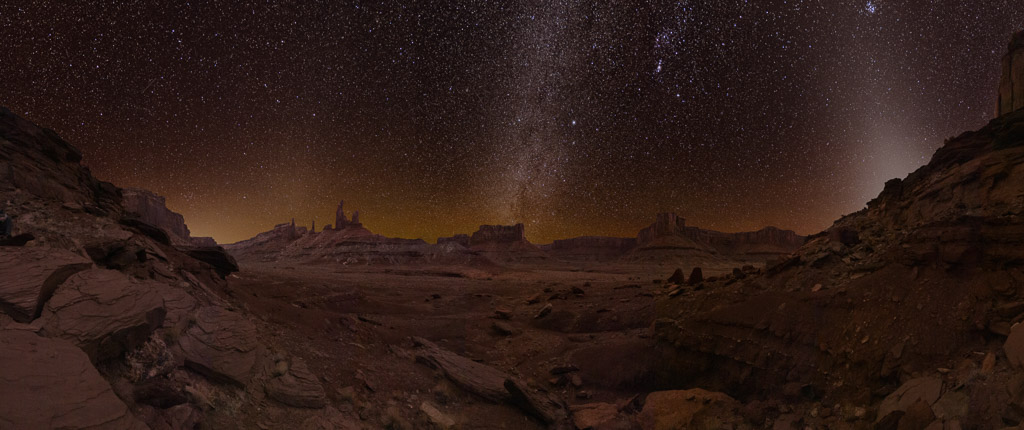
ZODIACAL LIGHT: What is that grey light in the sky?
In April 2018 I spent three nights solo at Taylor Canyon during the new moon, and the ‘seeing’ conditions were phenomenal, as evidenced by the wedge of Zodiacal Light practically obliterating the Milky Way in the west (in the image below). Prior to getting to the details, some fun background that many of you may know a snippet about due to the recent film Bohemian Rhapsody: You may have heard that Queen’s lead guitarist, Brian May, is an astrophysicist, a rather unique distinction for a rock god! Mr. May spent 33 years away from astrophysics, but finally returned to finish his doctoral thesis in 2007. Now here’s the fun part: his thesis–originally started nearly 40 years ago–concerned gathering spectrophotometer data of ‘Zodiacal Light’, which is the reflection of light off of dust in our solar system.
So, I can only assume that Mr. May would enjoy this image:

Anyone who has spent time in a dark location in the spring may have seen the Zodiacal Light emerge shortly after sunset, though may not have known what they were looking at. When it’s dark, the ‘wedge’ of Zodiacal Light extends 30-40° up into the sky, and can be quite bright near the horizon (it can look like light pollution from a nearby town, except the light is actually a bluish-grey color).
Being a 360° panorama, you can see many, many features of the night sky, however in this case it is more of a tour through the ‘winter’ night sky, as the galactic center of the Milky Way didn’t rise until nearly 6 hours after this image was captured. I approximated the arc of the ecliptic based upon the subtle brightening of the area of the sky along the zodiac. The lighter dotted lines forming the two ‘wedges’ are the Zodiacal Light and the Gegenschein, which lies at the opposite side of our solar system (away from the sun), and is where dust particles backscatter sunlight (it is thus much more faint). Zodiacal light is visible in the evening sky just after sunset in the west during early Spring, and to the east the during pre-dawn hours in the Fall.
[In order to compile this 360° panorama I used 21 vertical images from a 50MP Canon 5Ds, which resulted in an 80×20″ print (native 1:1 resolution at 300dpi), which could reasonably be printed at 120×30″! Images were captured in 20° increments over the course of 9 minutes, with an additional 30° on the left and right sides to offset for the slightly-upward camera angle. Each image was 15 seconds at f/2.8, ISO 3200 using the Tamron SP 15-30mm f/2.8 Di VC.]
MILKY WAY:
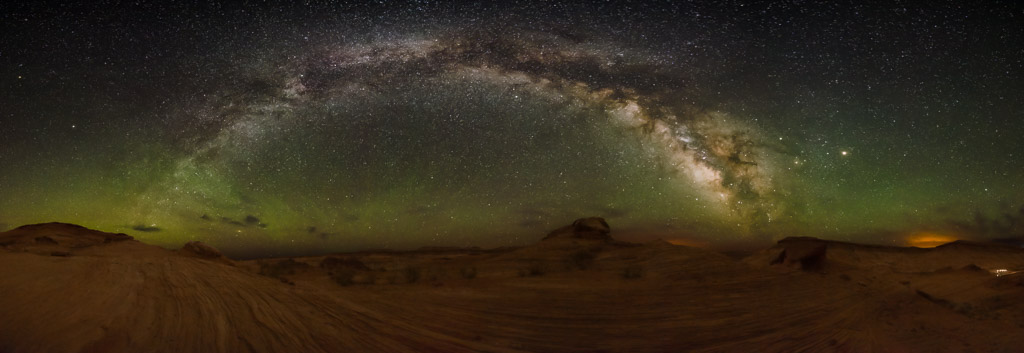
What can you say about the ‘Milky Way’, our solar system’s home, and the source of every single star that can be seen with the unaided eye? Well, perhaps a lot is warranted, but I’ll try to keep it somewhat brief:
Many people have not seen our galaxy from a dark-sky site, and it is something that can be hard to convey the nature of. Although a digital camera is capable of capturing far more detail and color than the human eye can perceive, many of the features seen in the image above can be seen under dark skies. This 270° panorama was captured above Lake Powell in the Glen Canyon National Recreation Area, a Bortle Class 1 site (the light pollution scale runs from Class 1, where no artificial light affects the night sky, to Class 9, which would be analogous to an inner-city location where barely a star can be seen). Note the dome of light in the right side of the image, which is light pollution from Kayenta, AZ, 60 miles to the southeast, a Bortle Class 4 location (the light pollution from Kayenta extends outward about 25 km before getting back to Class 1-2 dark sites).
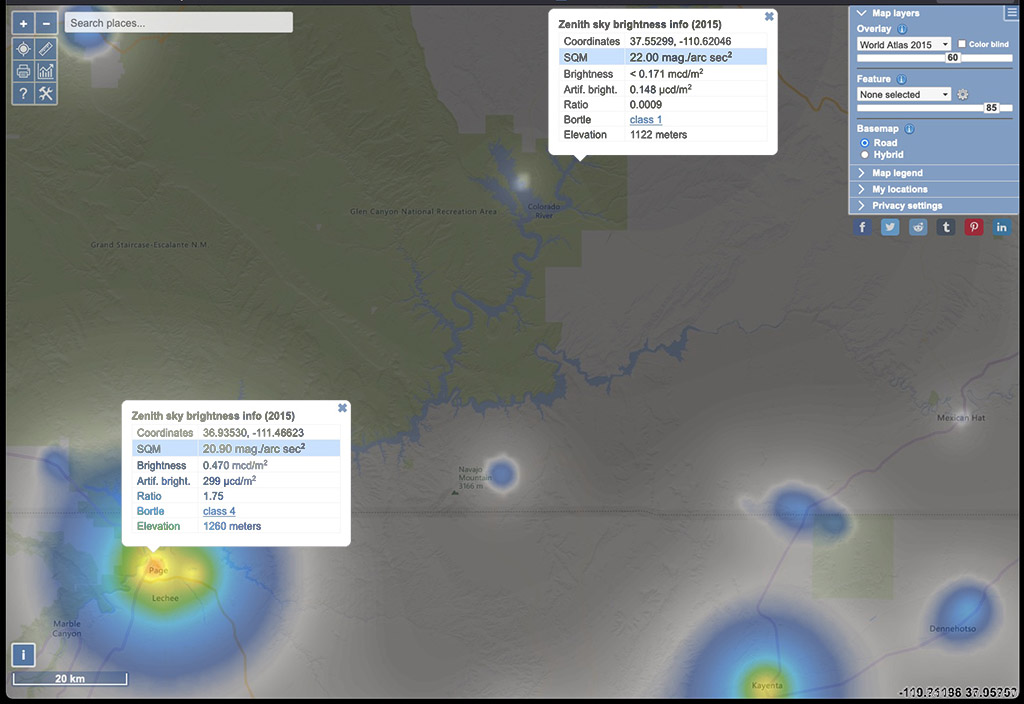
The Milky Way exhibits a variety of features far too numerous to go into here, but I’ll point out a few that may be useful or interesting while viewing the images on this site. First, the center of our galaxy, the galactic core, is situated at Sagittarius-A, which is in the vicinity of the brightest part of the arc of the Milky Way in the image above (it is actually a black hole which lies at the center of our galaxy). The brightest point of light in the image on the right side is Mars (-2.0 brightness), followed by Saturn (+0.0), and Antares (+1.07). Note that the brightness scale for stars is opposite of what seems intuitive, e.g. a negative value is brighter than a positive one. In the vicinity of these three bodies you can see one primary dark line that heads from Antares toward the arc of the Milky Way (the Pipe Nebula); this is actually dust that impedes the light from behind showing, and all of the dark parts within the arc of the Milky Way is indeed dust!
Just as our solar system is essentially a flat plane of planets orbiting our sun in a rough circle, the Milky Way that we see in the night sky also lies in a plane, all stars of which orbit around Sagittarius-A, the black hole at its center. The brightest part of the galaxy is near this actual center, just as our sun is the brightest part of (and is in the center of) our solar system. The plane of our solar system is not aligned with the plane of the Milky Way, thus it appears as a line of brightness in the sky, inclined at all different angles depending upon the time of night and the season. As presented in wide panoramas, the Milky Way looks like an arc, partially due to distortion in wide angle lenses and the corrections required to stitch the images together, but also because it is (especially at higher latitudes) inclined relative to our horizon, the arc of which does not go directly overhead. It is not a coincidence that our ecliptic (the path in the sky that our solar system’s planets traverse) also traces an arc in the sky, because the tilt of the earth on its axis is also inclined compared the plane of our solar system.
Now, when you hear ‘Milky Way image’, I think most people think of the above type of presentation, as you are facing the region of the galaxy that has the highest density of stars. Earth is situated in the Orion Arm of the galaxy (one of four) that is 27,000 light years from the center, which is approximately half the distance from the center to the outer edge. When we look away from the galactic core there is therefore much less brightness to the band our galaxy traces in the sky, but I feel it is no less impressive!
This region is often referred to as the ‘Winter’ or ‘Northern’ Milky Way, and is most visible in the northern hemisphere at night in the winter. There are lots of interesting things to see in this region of the sky, including Orion, the Pleiades, and Andromeda Galaxy, the only thing outside of our galaxy we can see unaided from the northern hemisphere. Note that in this west-facing view, the arc of the Milky Way now trends from southwest to northwest, nearly the opposite of the bright side of our galaxy.
I present, The ‘Other’ Milky Way:
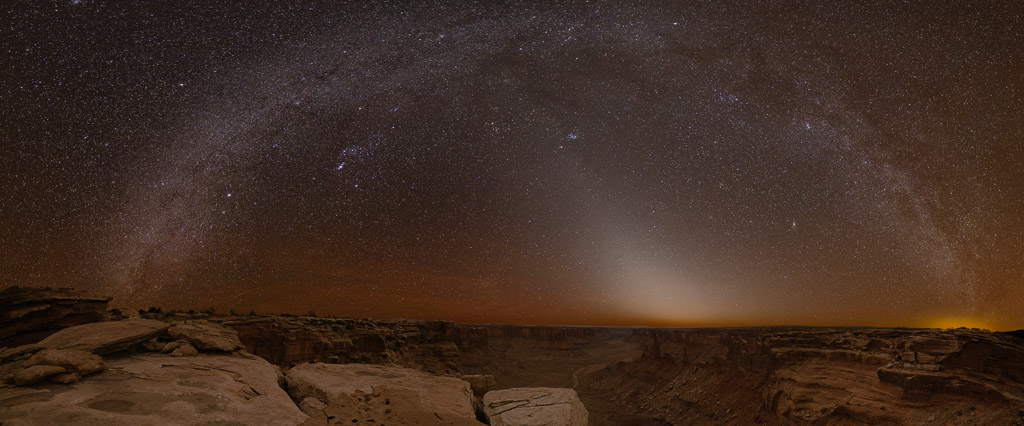
Comet C/2020 F3 Neowise, July 2020:
Magnitude +2.4 Comet NEOWISE (C/2020 F3) provided amazing opportunities for photographers, and the dynamic terrain around Crested Butte, Colorado allowed me to capture one image I was not sure I would (could?) get: a night landscape image containing both the Milky Way and Comet NEOWISE. The comet’s location in the northern part of the sky makes it quite challenging to portray along with the Milky Way, since it lies nearly 180° opposite, and is due south this time of year. Living in Colorado I am blessed with an amazing array of terrain to photograph in the Four Corners region, but Crested Butte is one of the places that is magical for a photographer. It is considered the ‘Wildflower Capital’ of Colorado, and its unique physiographic characteristics probably allowed it to become so. Mt. Crested Butte is the center around which many valleys essentially radiate outward, providing myriad opportunities for exploration, varied microclimates within each, while also exhibiting colorful rock somewhat characteristic of the volcanic San Juans to the south, dissimilar to the vast array of ‘grey’ plutonic mountains of central and northern Colorado.
Many things can impact the quality of night images (clouds, air transparency, a plethora of camera-related settings, airplanes and satellites, location and light pollution, timing, degree of darkness due to sun and moon, etc.), and fortunately it all came together for this robust 220° view panorama image. There are 24 satellites in this image, and zero airplanes (I can’t tell you what a revelation it was to be a night photographer in the times of COVID-19, as airplanes were practically non-existent compared to 7 months prior!). I’ve spent a fair bit of time photographing comets, and I think this night wins.
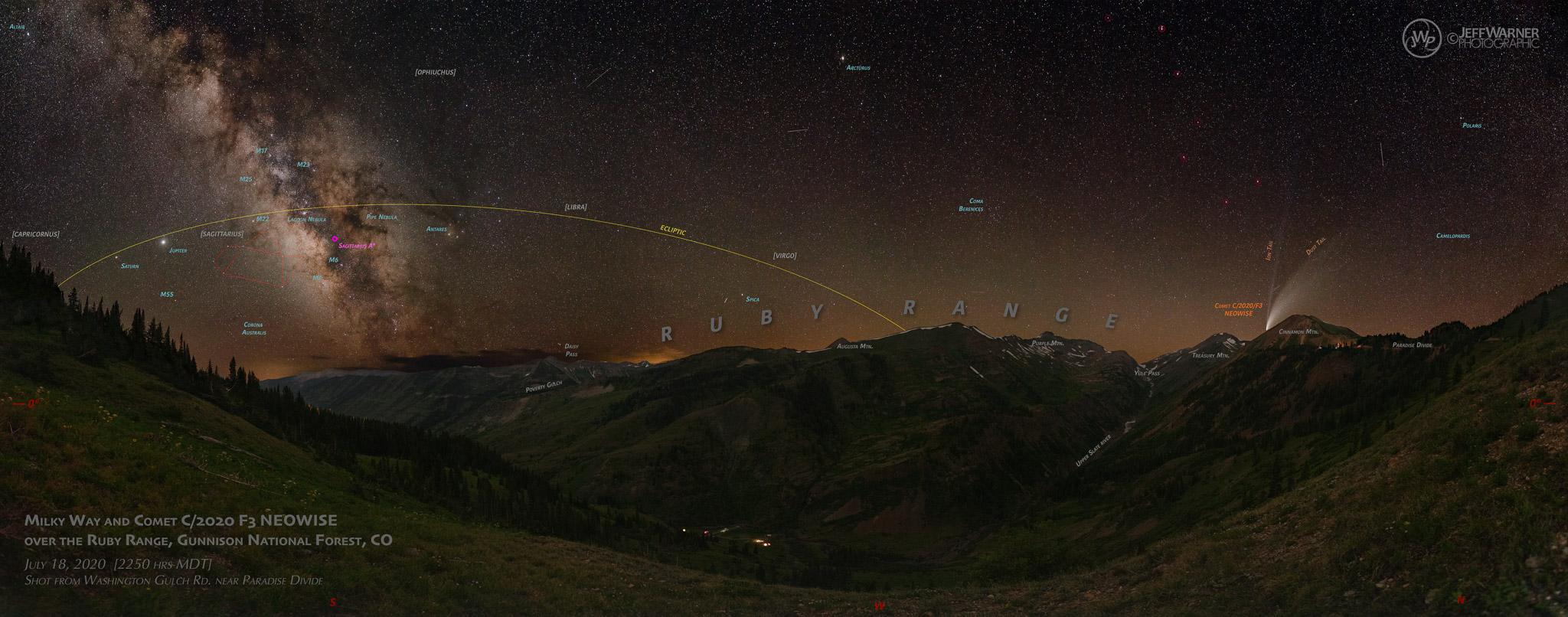
For this, my second night of photographing Comet NEOWISE, the weather cooperated and my choice of location–near Paradise Divide–worked out well for capturing both the Comet and the Milky Way. The Upper Slate River Basin is a captivating place, especially as viewed from my high perch at 10,843′ MSL on Washington Gulch Road as you approach Paradise Divide. The linear, steeply-sloping valley up to Yule Pass often has deep snow and avalanche debris at the bottom, sometimes not melting out prior to the following winter.
In the image above, Saturn and Jupiter are left of the Milky Way core (right along the line of the ecliptic, shown in yellow), while Comet NEOWISE’s two tails shine brightly as it sets over the flank of Cinnamon Mountain, near Yule Pass. The bluish, straight ion tail points directly at the sun, while the dust tail pushes to the right due to both comet movement (relative to the earth) and the influence of the solar wind. The camera position was in a Bortle Class 2 dark site, while the light pollution of Crested Butte (Class 3) and Gunnison (Class 4) can be seen as ‘domes’ of amber light on the left-center horizon, with lights from dispersed campers at Slate River (below center) and Paradise Divide (right of comet). Sky image was captured about 20 minutes after the end of astronomical twilight (e.g. during true night), with the waning crescent moon having set hours earlier. Perfect conditions.
Comet Neowise may have provided the best comet-viewing in the northern hemisphere that many of us may witness prior to departing this Earth. I feel incredibly fortunate to have viewed it from several dark-sky sites, and still marvel at how large and bright it was in the sky.
MOONLIGHT: What color is it?
I cannot say exactly why, but this is one of my favorite night photographs (the fact that it was taken near one of my favorite places on Earth might have something to do with it). This 180° panorama exhibits many aspects of the varying atmospheric effects upon the ambient light that illuminates the terrain before us, all in one image. The image was captured during nautical twilight, the waxing gibbous moon nearly full at 92% illumination. I don’t often image during the full moon, but capturing this image has made me re-think the value of incorporating the moon into more of my night landscape photography. The main reason I avoid shooting during the full moon is that the light on the landscape looks, to the camera, almost identical to daylight; aside from perhaps seeing stars in the sky, it can be hard to interpret that it is night. Of course there are approaches during post-processing to limit said effect, but this image required none of that; it came out how it came out! I think if I had waited until there was no horizon glow from the setting sun, the image would not have worked.
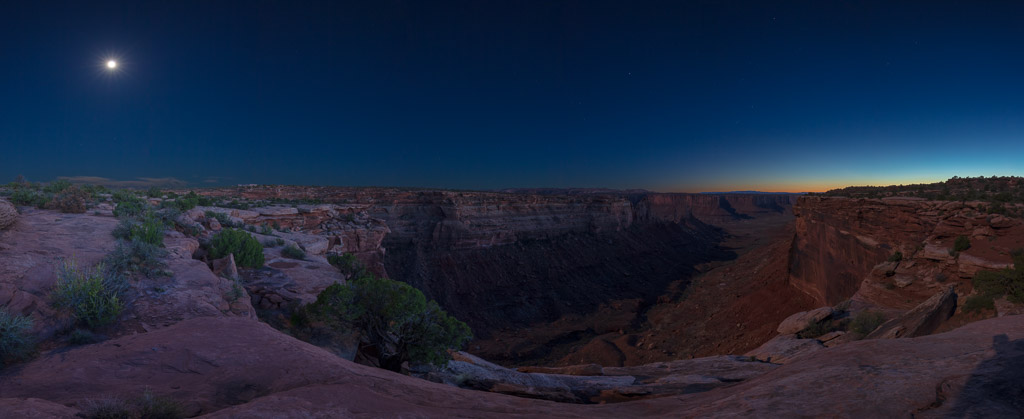
Anyway, what fascinates me about this image is the two distinct sources–and effects–of light, that is, the bluish light on the left side, and warm light bathing the canyon wall on the right. Moonlit landscapes impart a color that is even a bit ‘warmer’ (~4100K) than daylight (~5500K); the sun reflecting off the moon is sunlight, but it has again traveled through our atmosphere and reflects a bit redder than it started. Thusly, the canyon wall on the right is very warm, with the color of the rock looking close to the same color that it would appear in daylight. On the left side of the image, however, the camera is looking back into the moon, and much of what it sees is either in shadow, or is at a very low angle with respect to the height of the moon in the sky. This dictates that much of the light bathing the shadows is coming from the sky itself, which during blue hour (nautical twilight) is a result of our ozone layer interacting with the very low-angle light from the sun (Rayleigh Scattering is often cited as the reason the sky is blue, but this is mostly true during daytime).
Permit me another quick aside in regard to nocturnal human vision, or our lack thereof. As previously discussed, humans cannot differentiate colors very effectively at night, a result of our scotopic vision (an insensitivity to colors of light other than blue-green, in dim light). The result of this is that most people interpret scenes lit by the moon as being blue, even though said light is anything but (I fully acknowledge that it looks blue, in person). Another feature of human vision is its adaptability to color casts: after being in an environment with ‘colored’ light being the predominant source, our brains will adjust, and over 5-10 minutes that colored light will begin to look ‘normal’. If you’ve ever worn a pair of sunglasses that have an amber tint, you’ve probably noticed that when you put them on, things look quite yellow, initially; after having them on for awhile, when you take them off, all of sudden the world will appear to turn bluish-green, as the brain’s compensation for the yellow light becomes obvious, then progressively subsides.
Now, this presents a conundrum for me as a night photographer, since my goal is to present my images in the most natural light possible (excusing the pun). I do realize the artistic dichotomy presented by wanting to show images that are true to the actual color of the night sky, while our human eyes are nearly incapable of actually seeing said ‘true’ colors. I thus understand the Insta-blue night skies and Insta-grey Milky Way images, and that choice by other photographers is arguably more true to the scene witnessed by the photographer while capturing the image(s). My problem with artistically approaching night images in this way is that the result is that all images end up looking the same, i.e. night skies will be blue and the Milky Way will look grey. What would a beautiful sunset be if we saw a similar one every, single night? Would we even stop to notice, to try and observe how this day may have been different than the last?
My goal as a photographer has always been to present a view of the world that is relatively accurate and true to the source, while hopefully being as unique as that morning’s sunrise. Although some of my night skies are colorful, I do not add or appreciably change the color of that which existed when captured, i.e. that which the camera could see, but I could not. I would imagine I may lose a print sale or two by offering an image that is outside the bounds of what a casual observer might expect from the night sky (e.g. blue, like on Instagram and all National Park postcards), but it is my goal to show things on Earth that are harder to see, to notice or to appreciate directly. And, hopefully, to illuminate a viewer’s opinion as to which type of image may be more interesting…
Coming Soon:
Meteors and Persistent Trains:
ANATOMY OF A NIGHT PANORAMA COMPOSITE: Reference images showing stitching (foreground and sky), reference showing planes of focus
SATELLITES/SPACEX:
CLOUDS/TERRALAPSE:
GEOLOGY/ROCKS: Geo formation/geomorphology
BOONDOCKING:
LEAVE NO TRACE:
